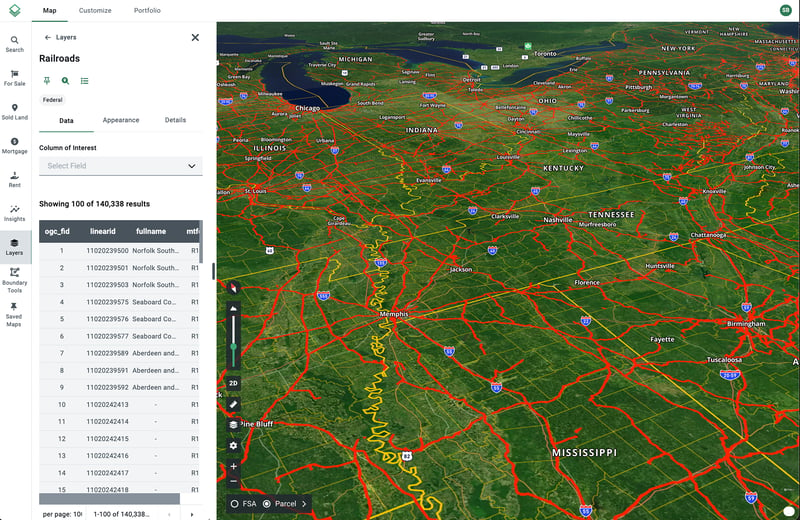When evaluating land for investment, development, or purchase, proximity to national railroad networks can significantly influence land value. Understanding these impacts can help stakeholders make informed decisions and maximize potential returns.
Acres.com provides a comprehensive overview of the nation’s railroad networks along with dozens of data layers.

Acres’ nationwide railroad data is derived from the US Census Bureau.
Dual Impact of Railroads on Land Value
Railroads' influence on land values are multifaceted, offering both challenges and opportunities depending on the region, zoning, and intended land use.
Positive Impacts on Land Value
- Commercial and Industrial Use: Proximity to rail transport may be advantageous for businesses reliant on efficient logistics, such as warehouses or manufacturing facilities.
- Development Potential: Land near railways may appreciate in value if nearby urban development increases demand for transit-oriented development (TOD).
- Market-Specific Advantages: Industries like agriculture, energy, and tourism may benefit significantly from rail access.
Negative Impacts on Land Value
- Noise Pollution: Frequent train traffic generates noise and vibration, which can deter residential or commercial interest.
- Limited Usage: Easements and restrictions tied to railroad properties can limit development flexibility.
- Environmental and Safety Concerns: Proximity to railroads can increase the likelihood of soil or water contamination from spills, posing environmental and safety hazards.
Considerations for Land Transactions
When buying or selling land near railroads, consider these essential factors:
- Zoning Regulations: Research zoning requirements that may apply due to railroad proximity.
- Transaction Costs: Prepare for additional expenses such as legal fees, surveys, and compliance measures.
- Insurance: Ensure adequate insurance coverage for liabilities associated with rail activity.
- Land Use Agreements: Collaborate with railroad companies on land-use agreements for maintenance or shared-use considerations.
Maximizing Value When Selling Railroad-Adjacent Land
Selling property near railroads involves addressing unique factors to ensure a seamless transaction and optimal value:
- Understand Railroad Activity: Investigate train traffic frequency and any planned changes to railroad usage.
- Highlight Development Opportunities: Emphasize advantages like TOD potential or benefits to specific industries.
- Prepare for Environmental Compliance: Conduct Environmental Site Assessments (ESAs) to address potential contamination concerns.
Final Thoughts
Railroads represent both an asset and a challenge for land value, depending on the property's characteristics and intended use. With strategic planning and informed decision-making, railroad-adjacent properties can serve as lucrative investments for the right buyers.
Start exploring the United States’ railroad map layer today!
.jpg)